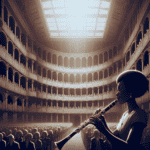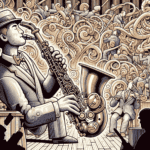Introduction to Historical Clarinet Notation Systems
The clarinet has a rich history, and with it comes an intriguing array of notation systems that have evolved over centuries. Understanding these historical clarinet notation systems can enhance your appreciation for the instrument and its music. So, grab your instrument and let's explore the fascinating world of clarinet notation!
Renaissance: The Roots of Musical Notation
Let's travel back to the Renaissance period when musical notation began to take shape. During this time, professionals created beautiful manuscripts filled with detailed notations, but they weren't specific to the clarinet yet. Instead, composers used a more general approach that applied to various instruments. This laid the groundwork for what would eventually become specialized clarinet notation.
Baroque Era: Clarinet's Solo Recognition
As we move to the Baroque era, the clarinet began gaining recognition as a solo instrument. Here, we start to see early adaptations in notation that are specific to the clarinet. For instance, clarinet parts would often use the treble clef, though this would depend on whether the clarinet was in a specific key, like B-flat or A. It was during these times that musicians had to be more adaptable, depending on the performance context!
| Era | Key Notation Features |
|---|---|
| Renaissance | General notation for various instruments |
| Baroque | Introduction of treble clef for clarinet, key-specific notation |
| Classical | Clear dynamics, articulations, and expression markings |
| Romantic | Elaborate symbols, specific markings for advanced techniques |
| 20th Century | Jazz notation, technology-aided notation systems |
Classical Era: Sophistication in Notation
An interesting turn of events happened in the Classical era. Notable composers like Mozart wrote some fantastic pieces for the clarinet. In these compositions, we see clearer indications of dynamics, articulations, and expression markings that guide the player on how to perform the piece. The notations were becoming more sophisticated, teaching players not just what notes to play but how to express them with emotion.
Romantic Era: The Evolution Continues
As we approach the Romantic era, it becomes increasingly evident that notation for the clarinet continued to evolve. Composers began using more elaborate symbols to convey their intentions. Techniques like flutter-tonguing and multiphonics needed specific markings. Without a doubt, this era significantly influenced how players interpreted clarinet music. Can you imagine trying to play a piece that had no instructions? It would be like driving a car without directions!
20th Century: Jazz and Technology
Now, let's appreciate the innovations introduced in the 20th century. The rise of jazz brought with it a whole new set of challenges for clarinetists. Players needed to quickly adapt to improvisational styles and, as a result, jazz notation evolved. Jazz charts often contain symbols that allow musicians to deviate from written notes, encouraging a more spontaneous form of performance. Why stick to what's on the page when you can let your creativity flow?
In addition to jazz notation, the advent of modern technology has also impacted how clarinet music is notated today. Software programs like Sibelius and Finale allow composers to easily create, edit, and share music. This change in notation has allowed for clearer, more precise symbols that appeal to today's players. So, whether you're a die-hard classical musician or a lover of contemporary styles, there's plenty of room for creativity!
Conclusion: The Journey of Clarinet Notation
Throughout this journey, we've seen how notation systems for the clarinet have changed. Each era brought its own set of challenges and innovations. But one thing remains constant: the passion for the clarinet and the music it creates. So the next time you sit down to play, take a moment to appreciate the detailed notations that guide your performance. They're not just symbols—they are a road map to musical expression!
As we think about the future of clarinet notation, it's exciting to consider where it might go next. Will we see entirely new forms of notation emerge? Perhaps there will be further integration of technology, blending traditional methods with digital advancements. Only time will tell, and as clarinet enthusiasts, we're all part of this ongoing story!
So grab your Martin Freres clarinet, explore the beautiful melodies it produces, and remember the historical notation systems that have shaped the path for musicians today. Happy playing!







